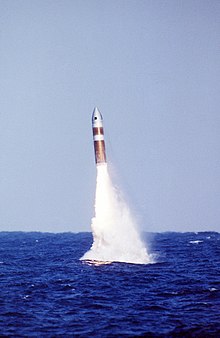
Back يو جي إم-73 بوسيدون Arabic UGM-73 Poseidon Czech UGM-73 Poseidon German UGM-73 Poseidon Spanish UGM-73 Poseidon Finnish UGM-73 Poseidon French UGM-73 Poseidon ID UGM-73 Poseidon Italian ポセイドン (ミサイル) Japanese UGM-73 포세이돈 Korean
| UGM-73A Poseidon C3 | |
|---|---|
 A Poseidon missile lifts off after being launched from the submerged USS Ulysses S. Grant (SSBN-631) in May 1979 | |
| Type | Strategic SLBM |
| Place of origin | United States |
| Service history | |
| In service | 31 March 1971 to September 1992 (Trident I phased in from October 1979) |
| Used by | United States Navy |
| Production history | |
| Manufacturer | Lockheed Missiles Division |
| Specifications | |
| Mass | 64,400 pounds (29,200 kg) |
| Length | 34.1 feet (10.4 m) |
| Diameter | 74 inches (1.9 m) |
| Warhead | 10 or 14 W68 warheads in Mark 3 RVs; 40 kilotonnes of TNT (170 TJ)[1] |
| Engine | Two-stage solid-fuel rocket, each single nozzle with thrust vectoring |
Operational range | With 14 RVs: 2,500 nautical miles (4,600 km), with 10 RVs: 3,200 nautical miles (5,900 km) |
| Maximum speed | 8,000 mph (13,000 km/h) (terminal phase) |
Guidance system | Inertial |
| Accuracy | 0.3 nautical miles (560 m) CEP |
The UGM-73 Poseidon missile was the second US Navy nuclear-armed submarine-launched ballistic missile (SLBM) system, powered by a two-stage solid-fuel rocket. It succeeded the UGM-27 Polaris beginning in 1972, bringing major advances in warheads and accuracy. It was followed by Trident I in 1979, and Trident II in 1990.
- ^ Minutes of National Security Council Meeting (Report). Parity, Safeguard, and the SS–9 Controversy. Washington DC. 1969-05-05. p. 119.
- ^ Cite error: The named reference
missilethreatwas invoked but never defined (see the help page).